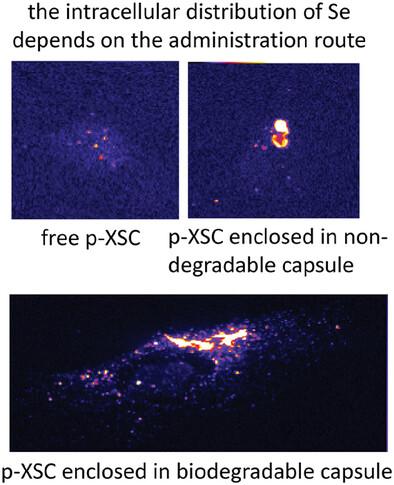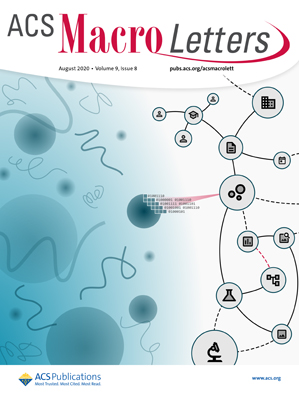利用 X 射线荧光成像技术探索生物可降解聚电解质胶囊递送的 Se 化合物在细胞内的分布情况
IF 5.1
Q1 POLYMER SCIENCE
引用次数: 0
摘要
硒(Se)化合物具有多种生物功能和氧化还原调节特性,有望成为治疗癌症的潜在药物。在本研究中,研究人员将一种疏水性硒化合物封装在由聚-L-精氨酸和葡聚糖组成的 5 微米大小的可生物降解聚电解质胶囊中。虽然该化合物的封装形式显示出与游离药物相当的细胞摄取和细胞毒性,例如没有提高抗癌功效,但这项研究获得了重要的启示。利用亚细胞分辨率同步加速器 X 射线荧光成像技术(XFI),在没有外源标记的情况下,通过展示胶囊的降解和随后化合物的重新分布,成功地观察到 Se 化合物在细胞内的位置。通过定量拟合方法,确定载体降解后细胞内 Se 的质量为 0.09 ± 0.01 pg。这凸显了 XFI 作为一种追踪金属基药物细胞内动态的强大工具的潜力,可促进临床药物开发。本文章由计算机程序翻译,如有差异,请以英文原文为准。

Exploring the Intracellular Distribution of Se Compounds Delivered by Biodegradable Polyelectrolyte Capsules Using X-Ray Fluorescence Imaging
Selenium (Se) compounds hold promise as potential therapeutics for cancer due to their diverse biological functions and redox-regulating properties. In this study, the encapsulation of a hydrophobic selenium compound inside 5 µm sized biodegradable polyelectrolyte capsules consisting of poly-L-arginine and dextran is investigated. While the encapsulated form of the compound showed comparable cellular uptake and cytotoxicity as the free drug, e.g. no improved anti-cancer efficacy is achieved, the investigation yielded crucial insights. Utilizing subcellular resolution synchrotron X-ray fluorescence imaging (XFI), the intracellular location of the Se compound is successfully visualized by demonstrating the degradation of the capsules and the following redistribution of the compound, without exogenous labeling. By applying a quantitative fitting approach, the intracellular Se mass is determined to be 0.09 ± 0.01 pg after degradation of the carrier. This highlights the potential of XFI as a powerful tool for tracking intracellular dynamics of metal-based drugs, which may facilitate drug development in the clinic.
求助全文
通过发布文献求助,成功后即可免费获取论文全文。
去求助
来源期刊
CiteScore
10.40
自引率
3.40%
发文量
209
审稿时长
1 months
期刊介绍:
ACS Macro Letters publishes research in all areas of contemporary soft matter science in which macromolecules play a key role, including nanotechnology, self-assembly, supramolecular chemistry, biomaterials, energy generation and storage, and renewable/sustainable materials. Submissions to ACS Macro Letters should justify clearly the rapid disclosure of the key elements of the study. The scope of the journal includes high-impact research of broad interest in all areas of polymer science and engineering, including cross-disciplinary research that interfaces with polymer science.
With the launch of ACS Macro Letters, all Communications that were formerly published in Macromolecules and Biomacromolecules will be published as Letters in ACS Macro Letters.

 求助内容:
求助内容: 应助结果提醒方式:
应助结果提醒方式:


